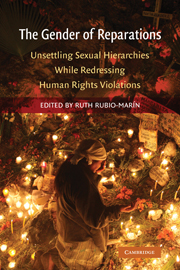Book contents
- Frontmatter
- Contents
- Acknowledgments
- Contributors
- Photo Credits: “Gender, Memorialization, and Symbolic Reparations,” in The Gender of Reparations
- International Center for Transitional Justice (ICTJ)
- Introduction: A Gender and Reparations Taxonomy
- 1 Gender and Violence in Focus: A Background for Gender Justice in Reparations
- 2 The Gender of Reparations in Transitional Societies
- 3 Reparation of Sexual and Reproductive Violence: Moving from Codification to Implementation
- 4 Reparations as a Means for Recognizing and Addressing Crimes and Grave Rights Violations against Girls and Boys during Situations of Armed Conflict and under Authoritarian and Dictatorial Regimes
- 5 Repairing Family Members: Gross Human Rights Violations and Communities of Harm
- 6 Tort Theory, Microfinance, and Gender Equality Convergent in Pecuniary Reparations
- 7 Gender, Memorialization, and Symbolic Reparations
- 8 Gender and Collective Reparations in the Aftermath of Conflict and Political Repression
- Index
- References
3 - Reparation of Sexual and Reproductive Violence: Moving from Codification to Implementation
Published online by Cambridge University Press: 25 August 2009
- Frontmatter
- Contents
- Acknowledgments
- Contributors
- Photo Credits: “Gender, Memorialization, and Symbolic Reparations,” in The Gender of Reparations
- International Center for Transitional Justice (ICTJ)
- Introduction: A Gender and Reparations Taxonomy
- 1 Gender and Violence in Focus: A Background for Gender Justice in Reparations
- 2 The Gender of Reparations in Transitional Societies
- 3 Reparation of Sexual and Reproductive Violence: Moving from Codification to Implementation
- 4 Reparations as a Means for Recognizing and Addressing Crimes and Grave Rights Violations against Girls and Boys during Situations of Armed Conflict and under Authoritarian and Dictatorial Regimes
- 5 Repairing Family Members: Gross Human Rights Violations and Communities of Harm
- 6 Tort Theory, Microfinance, and Gender Equality Convergent in Pecuniary Reparations
- 7 Gender, Memorialization, and Symbolic Reparations
- 8 Gender and Collective Reparations in the Aftermath of Conflict and Political Repression
- Index
- References
Summary
INTRODUCTION
The last decade has seen unprecedented progress in the construction of an international legal framework for the criminalization and prosecution of gender crimes perpetrated against women and girls during armed conflict or state repression. The visibility of gender-based violence, especially sexual and reproductive violence (SRV), is now an important part of the legacy of international criminal law. Rape is included in the definitions of a “grave breach” of the Geneva Conventions, of crimes against humanity, and of genocide. Sexual slavery, rape, enforced prostitution, pregnancy and sterilization, and other forms of sexual violence are listed as war crimes and as crimes against humanity in the Rome Statute of the International Criminal Court. Significant changes in the rules and procedures for prosecuting gender crimes in international criminal tribunals and other significant “soft law” milestones leave no doubt that we have now reached a watershed moment in galvanizing international attention around the egregious forms of violence that befall women and girls during wartime or periods of mass human rights abuse. As part of this growing commitment, in June 2006 more than 250 representatives of governments, nongovernmental organizations (NGOs), women's organizations, human rights activists, UN agencies, parliaments, the research community, international criminal courts, military, police, and the media met at the International Symposium on Sexual Violence in Conflict and Beyond to exchange strategies for addressing and preventing incidents of SRV in war-affected countries.
- Type
- Chapter
- Information
- The Gender of ReparationsUnsettling Sexual Hierarchies while Redressing Human Rights Violations, pp. 121 - 161Publisher: Cambridge University PressPrint publication year: 2009
References
- 4
- Cited by

